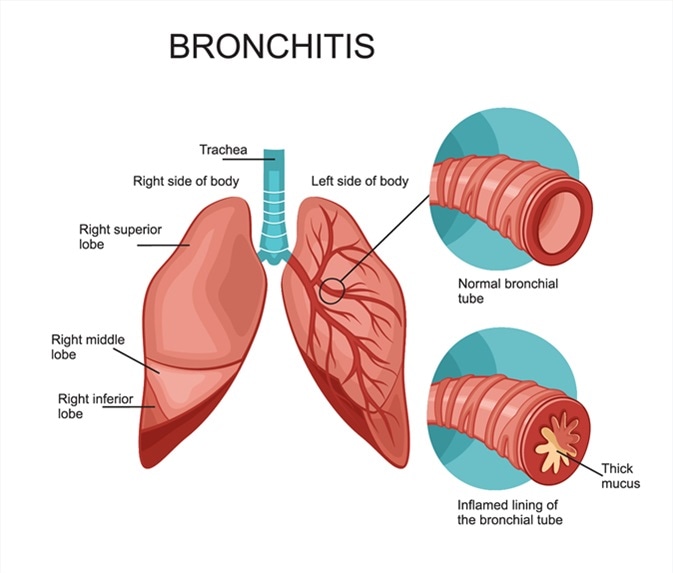“Flash bronchitis” appears to be a colloquial term, possibly referring to the sudden onset of acute bronchitis. Acute bronchitis is typically caused by viral infections, such as those that cause colds or the flu, and it involves inflammation of the bronchial tubes in the lungs. This condition is characterized by symptoms like a persistent cough, production of mucus, fatigue, shortness of breath, slight fever, and chest discomfort.

Symptoms and Diagnosis:
-
Symptoms include a persistent cough (often with mucus), fatigue, shortness of breath, slight fever and chills, and chest discomfort .
-
Diagnosis is usually based on medical history, physical examination, and sometimes additional tests like chest X-rays to rule out pneumonia, blood tests to check for infection, or sputum tests to identify the presence of a virus or bacteria.
Treatment:
-
Medications are typically not required for viral bronchitis, but treatments can include over-the-counter pain relievers, cough suppressants, and in some cases, bronchodilators or corticosteroids to reduce inflammation and open airways .
-
Home Remedies such as staying hydrated, using a humidifier, and resting can also help manage symptoms. Avoiding lung irritants like smoke is crucial .
Prevention:
-
Preventive measures include frequent hand washing, avoiding close contact with people who are sick, getting vaccinated against the flu and pneumonia, and avoiding smoking and other lung irritants .
When to See a Doctor:
-
If the cough lasts more than three weeks, is accompanied by a high fever, produces discolored or bloody mucus, or if there is wheezing or shortness of breath, it is important to consult a healthcare provider .
Causes:
Flash bronchitis, more commonly referred to as acute bronchitis, is an inflammation of the bronchial tubes in the lungs, often triggered by viral infections such as the common cold or influenza. Bacterial infections can also cause acute bronchitis, though this is less common. Other contributing factors include exposure to tobacco smoke, air pollution, dust, fumes, and chemicals, which can irritate the bronchial tubes and lead to inflammation. People with weakened immune systems, such as the elderly or those with chronic illnesses, are more susceptible to developing acute bronchitis .
Symptoms:
The hallmark symptom of acute bronchitis is a persistent cough, which may produce mucus. Other common symptoms include:
-
Chest discomfort or pain
-
Fatigue
-
Shortness of breath
-
Slight fever and chills
- Wheezing These symptoms typically develop a few days after the onset of a respiratory infection and can last for several weeks. Acute bronchitis should be distinguished from chronic bronchitis, a long-term condition often associated with chronic obstructive pulmonary disease (COPD), characterized by a productive cough lasting at least three months in two consecutive years .
Deaths:
While acute bronchitis itself is rarely fatal, complications from the condition can be serious, especially in vulnerable populations such as the elderly, infants, and those with underlying health conditions. Severe cases can lead to pneumonia or exacerbate existing respiratory diseases like asthma or COPD. Chronic bronchitis, a component of COPD, is a significant contributor to respiratory-related mortality worldwide. According to the World Health Organization (WHO), COPD, which includes chronic bronchitis, is the third leading cause of death globally, responsible for approximately 3.23 million deaths in 2019.
Impact:
Acute bronchitis has a substantial impact on public health due to its high prevalence and the burden it places on healthcare systems. The condition leads to millions of medical consultations annually, resulting in significant healthcare costs and loss of productivity. In low- and middle-income countries, the impact is more pronounced due to higher exposure to risk factors such as indoor air pollution from biomass fuels and inadequate access to healthcare services.
The economic burden of bronchitis and related respiratory conditions includes direct medical costs (doctor visits, medications, hospitalizations) and indirect costs (lost workdays and reduced productivity). In high-income countries, tobacco smoking is the primary risk factor for bronchitis and COPD, while in low- and middle-income countries, indoor air pollution from cooking and heating fuels is a major contributor .
Preventive measures include smoking cessation programs, reducing exposure to lung irritants, and ensuring proper vaccination against respiratory infections such as influenza and pneumococcal pneumonia. Public health initiatives aimed at improving air quality, both indoors and outdoors, are essential for reducing the incidence and severity of bronchitis and other respiratory conditions.
In conclusion, while flash bronchitis is typically a self-limiting condition, its prevalence and potential for serious complications underscore the importance of preventive measures and effective management strategies. Addressing the root causes and providing appropriate medical care can significantly mitigate its impact on individuals and healthcare systems globally.
While “flash bronchitis” isn’t a standard medical term, the information above provides a comprehensive overview of acute bronchitis, which might be what the term refers to. For further details on symptoms, treatment, and prevention, you can refer to resources from the Mayo Clinic and Cleveland Clinic.






